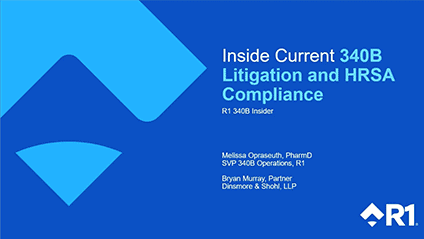The many faces of 340B policies and procedures
For 340B covered entities (CEs), a Health Resources and Services Administration (HRSA) audit is an inevitability. While you won’t be able to predict when HRSA comes calling, you can bank on sooner or later being one of the 200 CEs HRSA audits every year. That’s why R1 recommends keeping your organization’s policies and procedures aligned with current 340B program guidance and expert interpretations. When the audit comes, you want to be one of the CEs with a clean outcome, not one of those saddled with findings that could jeopardize your program.
A critical component of a compliant 340B program is having your policies and procedures in good order before the audit. They must identify how you ensure key compliance measures are met for the 340B program, including patient definition, care setting and other factors.
Beyond setting the applicable policies and procedures, you must ensure you also implement them exactly as they are written. It’s helpful to have a knowledgeable partner be a second set of eyes to examine your policies and procedures, be it your third-party administrator (TPA), independent consultant or other 340B vendors.
Empower your people to manage proactively
Even with well-developed policies and procedures, it also pays to have a 340B steering committee structure in place that brings together key internal stakeholders. This should include those not directly involved in the day-to-day 340B program management or working exclusively in pharmacy, such as finance, credentialing, legal and contracting. Their roles often have both direct and indirect impact on the program, so they should be familiar with current policies and procedures and any changes or updates that are made.
Proactive program management also means weekly, monthly or quarterly internal audits and reviews of claims records to ensure everything is updated and accurate, as well as annual reviews of the actual policies and procedures. Consider an annual external audit or internal mock audit to help uncover any gaps between policy and process.
Policy and procedure keys to compliance
- Patient definition:
- Location of care
- Provider of care
- Care documented in EHR
- Prevention of diversion
- Prevention of duplicate discounts
- Audit processes
Connecting the documentation dots for patient eligibility
Covered entities have to show that they are responsible for a patient’s care, even when a patient sees a specialist at a different facility. This can include providing proof of provider-entity relationships, documenting all referrals and their resulting prescriptions and maintaining patient notes from internal and external providers. Because the data required to document eligible prescriptions typically resides in multiple, disparate systems, providers need to establish workflows and procedures for collecting, compiling and reconciling eligibility data to achieve the operational capacity needed for ongoing audit preparedness.
Focusing on referral prescription compliance
While covering a variety of compliance concerns in your policies and procedures, ensuring referral prescription compliance is crucial. According to HRSA 340B FAQ 1493, covered entities that can document ownership of patient care throughout the referral can claim discounts for 340B prescriptions written by the referred provider.
CEs do have some flexibility in patient and referral definitions, with the close loop model being the most widely used, but HRSA states that how you count referrals must be addressed in your written policies and procedures. At minimum, HRSA requires the referral be documented in the EHR, including proof of patient encounters with both the referring and referred-to providers. However, audit-proof 340B referral prescription claims go much further to include routine self-auditing and internal corrective action.
Reaping the benefits of being prepared
Though you will not know when HRSA wants to examine your program and you might not know what it wants to investigate, having solid policies and procedures already in place will give you the confidence to make the HRSA audit a more positive experience – one that helps improve your program so you can focus on delivering more comprehensive and accessible care. Make sure your policies and procedures set you up for that success. R1’s compliance-first approach is verified by our clients’ HRSA audits – 100% of our clients’ audits resulted in zero findings.
Get preparation tips from recently audited providers in our eBook, The Covered Entity’s Guide to 340B HRSA Audits.
To learn more about 340B program compliance and audit preparation, visit our HRSA Audit-Ready Resource Center.





